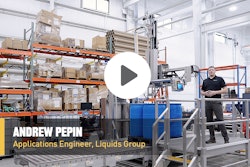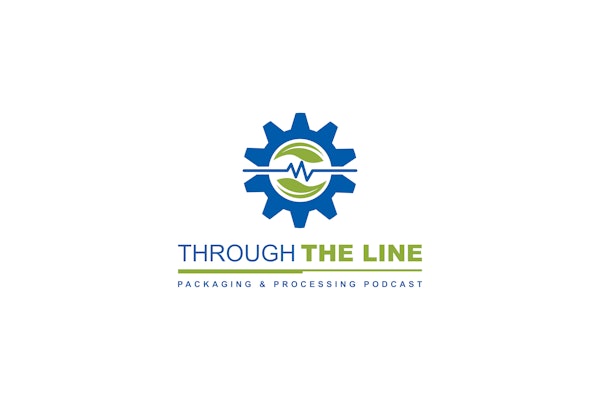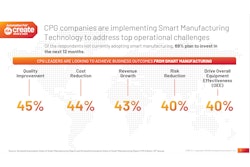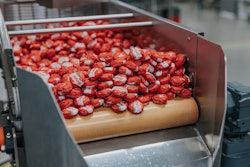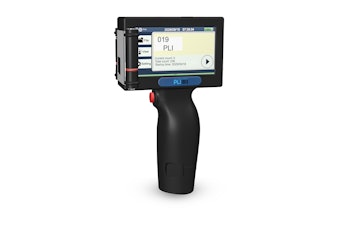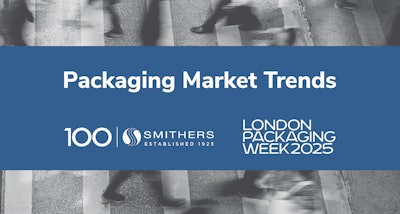
To mark the 15th edition of London Packaging Week, which opened Oct.15 at ExCeL London, Smithers released a special white paper, “Packaging Market Trends,” capturing how far the industry has come since 2010 and identifying four megatrends shaping its future: sustainability, e-commerce, consumer behavior, and regulation.
According to the white paper, when the first London Packaging Week launched in 2010, Western Europe’s packaging market was valued at $193.4 billion. E-commerce was emerging, sustainability was a niche topic, and global packaging growth was steady but unspectacular.
Fifteen years later, packaging is a trillion-dollar global industry that has proved remarkably resilient amid supply-chain disruptions and economic pressures. Paper and board hold the largest market share at 38.9% (2023), followed by PET in rigid plastics and polyethylene in flexibles. Growth in molded fiber has further advanced fiber-based packaging, making it more durable and cost-efficient.
The report forecasts steady expansion, driven by urbanization, population growth, and technological innovation, confirming packaging’s enduring role as both an economic and environmental bellwether.
E-Commerce: from emerging niche to global powerhouse
In 2010, online retail represented only a fraction of global sales. Fast-forward to 2025, and e-commerce now generates $6.4 trillion, accounting for over 20% of all retail and growing faster than physical stores.
Notes the white paper, this shift has transformed packaging design. The e-commerce packaging market, worth $81.6 billion in 2025, is expected to exceed $100 billion by 2028, with corrugated materials making up around 81% of total use.
Meal delivery—almost non-existent 15 years ago—has become a major driver of packaging innovation, prompting demand for lightweight, recyclable, and compostable paper-based containers. E-commerce has moved packaging from shelf appeal to structural efficiency, reinforcing its strategic importance to logistics and customer experience alike.
Consumers and the demand for convenience
In 2010, most packaging was built for in-store shopping and family-sized consumption. By contrast, the 2025 consumer expects products that match fast-paced, urban lifestyles.
The report shows that more than half the world’s population now lives in cities, with rising disposable incomes boosting consumption of packaged goods. Key findings include:
- 83% of consumers say convenience matters more than it did five years ago.
- 66% of millennials expect one-hour delivery in urban areas.
- 70% want minimal packaging from online retailers.
These expectations are driving demand for smaller, resealable, and easy-to-handle formats. The evolution from bulk to convenience marks one of the most dramatic behavioral shifts since 2010.
Sustainability becomes standard practice.
Sustainability has moved from the sidelines to the center of global strategy. In 2010, eco-friendly materials were a marketing niche; today, they are a competitive necessity.
 Smithers
Smithers
Smithers defines sustainable packaging as minimizing environmental impact and reducing dependence on fossil-based materials. Europe leads progress, driven by legislation and consumer demand, with fiber-based materials, including molded pulp, making up 39.8% of global packaging consumption (2023).
However, the transition away from fossil-based polymers remains uneven. In Asia, Latin America, and North America, lower costs, limited recycling infrastructure, and slower policy adoption continue to favor conventional plastics. Europe’s regulatory frameworks, such as Extended Producer Responsibility (EPR) and the Packaging and Packaging Waste Regulation (PPWR), are accelerating circular solutions and setting the global pace.
Regulation is redefining market priorities
Fifteen years ago, environmental regulation was fragmented and largely voluntary. Today, it is a defining market force. The PPWR, effective from February 2025, mandates recyclability by 2030, waste reduction, and increased recycled content. Coupled with EPR and Deposit Return Systems (DRS), these policies are shifting the cost and responsibility of waste back to producers.
Smithers calls this “the biggest regulatory change ever seen in the packaging industry.” Compliance now requires innovation—from material substitution to new collection models—as companies align profitability with environmental accountability.
Adapting for the next decade of growth
The “Packaging Market Trends” report forecasts the global packaging market will grow at a 3.8% CAGR, reaching $1.43 trillion by 2028, then moderating to 2.1% annual growth through 2050. High-income markets will lead in innovation and premiumization, while emerging economies will drive volume and accessibility.
The contrast between 2010 and 2025 underscores an industry in transition—from cost-focused to circular and from static to adaptive. The next decade, Smithers concludes, will belong to companies that can balance growth with responsibility, integrating design, regulation, and sustainability into every layer of packaging production. PW




